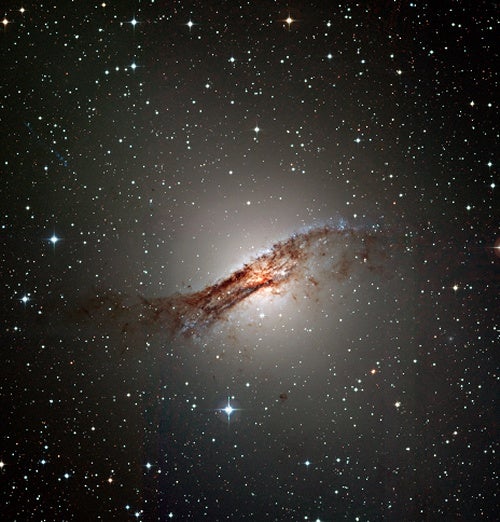The 14 largest globular clusters belonging to a giant elliptical galaxy in Centaurus may be the remains of destroyed dwarf galaxies, say astronomers.
“These globular clusters are much more massive than most clusters in the Milky Way or the Andromeda Galaxy,” says Paul Martini (Harvard-Smithsonian Center for Astrophysics), the lead author on the study carried out with Luis Ho (Observatories of the Carnegie Institution of Washington). The team used the 6.5-meter (256-inch) Magellan Clay telescope at Las Campanas Observatory in the Chilean Andes to examine the clusters’ motions and masses, and to confirm their size. Martini and Ho published their results in the July 20, 2004, issue of The Astrophysical Journal.
“The essence of our findings,” Martini continues, “is that these 14 globulars are ten times more massive than the smaller globulars in our neighborhood, and whatever process makes them can produce some really huge objects — they begin to overlap with the smallest galaxies.”
Martini notes that other astronomers have raised the idea of the largest globular clusters being the central remnants of dwarf galaxies. One possible example of this that belongs to the Milky Way is the globular cluster Omega Centauri. Another is G1, a globular that’s part of the Andromeda Galaxy. “However,” says Martini, “globulars are much more centrally concentrated than the lowest-mass galaxies.”
This difference helped the astronomers pinpoint a possible source for the massive globulars in NGC 5128: a subtype of low-mass galaxies called nucleated dwarf ellipticals. If such a galaxy passed near enough to NGC 5128, it would be stripped of its outer stars, leaving only a globular-cluster-like nucleus.
NGC 5128, Martini notes, lies about 12.5 million light-years away and is well known for devouring smaller bodies that come too close — that’s how astronomers think it grew to its present mass, about twice that of the Milky Way. Recent observations with the Spitzer Space Telescope support this idea, showing that NGC 5128 contains a rumpled disk of dust at its core. This is the remains of a spiral galaxy it swallowed some 200 million years ago.
“One model for triggering globular clusters to form is through the disruptions that occur when large galaxies collide,” Martini says. “Another theory suggests existing globulars may have been torn off the impacting galaxy.”
He continues, “Some astronomers have found the globulars in NGC 5128 are at least a billion years old and perhaps several billion years old. We’d like to determine their ages more exactly because that should help us determine if the globulars formed when the last major collision occurred.”










